Generative AI development solutions use an AI model to learn the patterns and the relationships in a dataset of human-created content and then use it to generate new content.
Updated 15 August 2024

CEO at Appventurez
AI-powered digitization is leading a cycle of innovation, ranging from Augmented Reality to Generative AI development services. Generative AI represents cutting-edge technologies that creatively transform businesses, helping them grow profoundly in their niche.
Groundbreaking generative AI is a phenomenon that catalyzes innovation in the way we approach the content creation, including text, imagery, audio, and synthetic data. The recent buzz around generative AI development services has also been driven by the simplicity of new user interfaces for creating high-quality text, graphics, and videos in a matter of seconds.
Our comprehensive guide on generative AI development breaks down the types, examples, applications, benefits, and challenges of generative AI development so that you can maximize your overall customer experience now and in the future.
Generative AI is a subset of AI that has significant applications in various fields, including music, art, writing, and advertising.
It is capable of generating content or data autonomously, such as images, texts, entire datasets, and other content. As per the latest report, the rising demand for Generative AI products can add about $280 billion of new software revenue, driven by specialized virtual assistants, new infrastructure products, and copilots that accelerate coding.
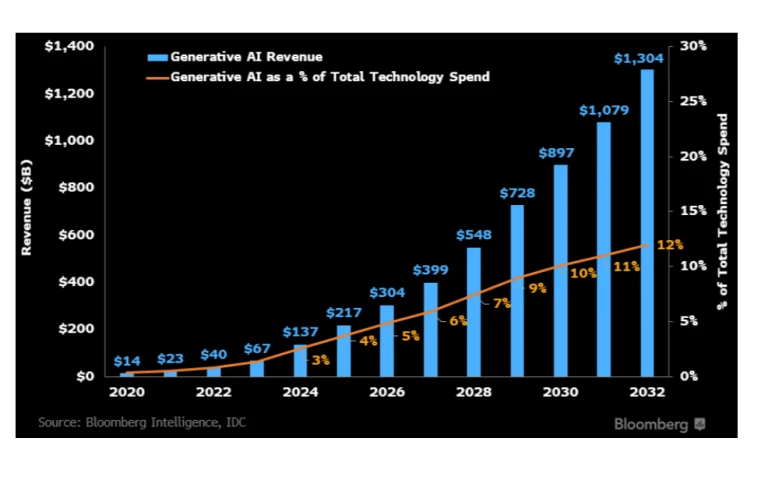
Source: Bloomberg
Generative AI development solutions facilitate the generation of content, based on a variety of user input and trained data and are also utilized in various applications, including text generation, image generation, and the development of human-like chatbots.
By facilitating data augmentation it generates new data to supplement a small dataset and synthetic data generation where it generates data for tasks that are difficult and or expensive to collect in the real world.
Generative AI works by using algorithms to analyze the patterns and the relationships with the existing data. The working mechanism of Generative AI is entirely based on how comprehensively it has gone through the training processes in huge datasets.
For example, just like we teach kids how to recognize an image of someone through its visual or textual interpretation, Generative AI also goes through a similar type of training or reading process.
One of the major breakthroughs with Generative AI models is its ability to leverage different learning approaches, further including supervised or unsupervised learning for training.
In the realm of artificial intelligence development services, generative AI models have emerged as powerful tools that are capable of creating new and imaginative content. By leveraging sophisticated algorithms and deep learning techniques, these models enable the machines to generate realistic images, texts, music, and even videos that mimic human creativity.
Generative AI development models are also designed to learn from vast amounts of data and generate new content that resembles the original data distribution. These models also go beyond simple classification or prediction tasks and aim to create new samples that exhibit intellectual, artistic, or other desirable qualities.
There are numerous types of Generative models, each designed for specific tasks and use cases.
This diversity ensures that Generative AI development solutions can be harnessed effectively in a wide range of applications, further meeting the diverse needs of businesses and researchers. From task suitability to interpretability and data requirement, each type of data model has distinctive characteristics. Let’s explore some of the advanced Generative AI models.
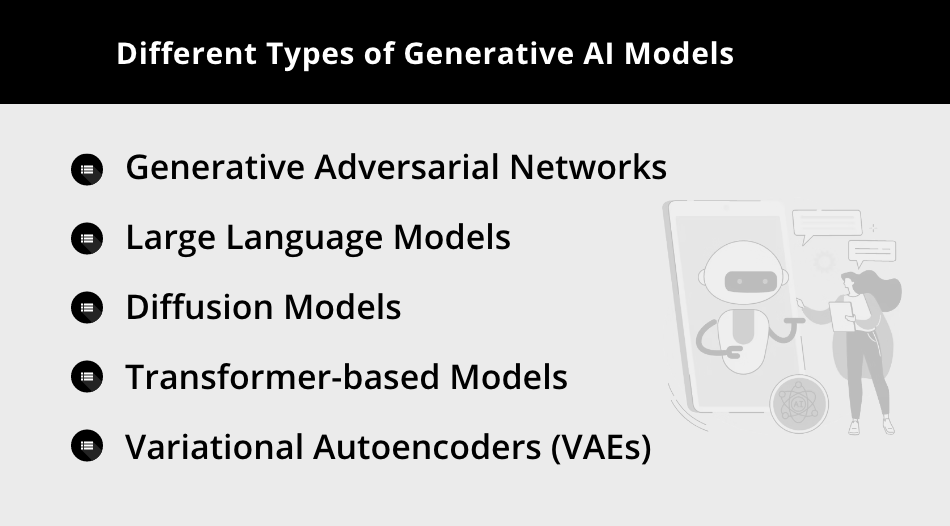
A generative adversarial network (GAN) is a machine learning algorithm that puts the two neural networks- generator and discriminator- against each other, hence the adversarial part.
The contest between the two neural networks takes the form of a zero-sum game, where one agent’s gain is another agency’s loss. This dynamic equilibrium results in amazing creations, whether it is generating lifelike images, realistic text, or even style transfer.
These are the advanced natural language processing solutions that are designed with extensive neural networks and pre-trained on vast datasets to generate human-like text on a wide array of topics and tasks.
These generative AI development models have proficiency in text generation, summarization, and translation, offering practical applications, and even code generation. While their capabilities are remarkable, they also raise concerns about ethical use, privacy, and responsible AI development, necessitating careful oversight and responsible implementation in various domains.
From helping computers understand complex things by breaking them down into simpler steps to making a blurry picture clear, this generative model is designed to estimate the complex probability distributions over data.
Unlike the traditional Generative AI models, diffusion models follow an interactive approach to progressively refine the data distribution.
Powered by advanced natural language processing and machine learning development services, transformer-based models demonstrate remarkable proficiency in text generation, language translation, information retrieval, and more.
The core innovation of the transformers lies in their ability to parallelize the processing of data. Additionally, the Transformers excel in capturing the long-range dependencies within sequences, making them highly adept at handling complex relationships and context in language.
This generative AI development model employs an encoder-decoder architecture to capture and generate complex data distributions. It harnesses the combined power of autoencoders and probabilistic modeling.
What sets VAEs apart is their power to not just reconstruct the data but also traverse a latent space of possibilities. VAEs are used to generate realistic images, art synthesis, texts, audio, anomaly detection, and more.
Building a Generative AI model is a structured journey and the process mentioned below will take you through the entire generative AI development process.
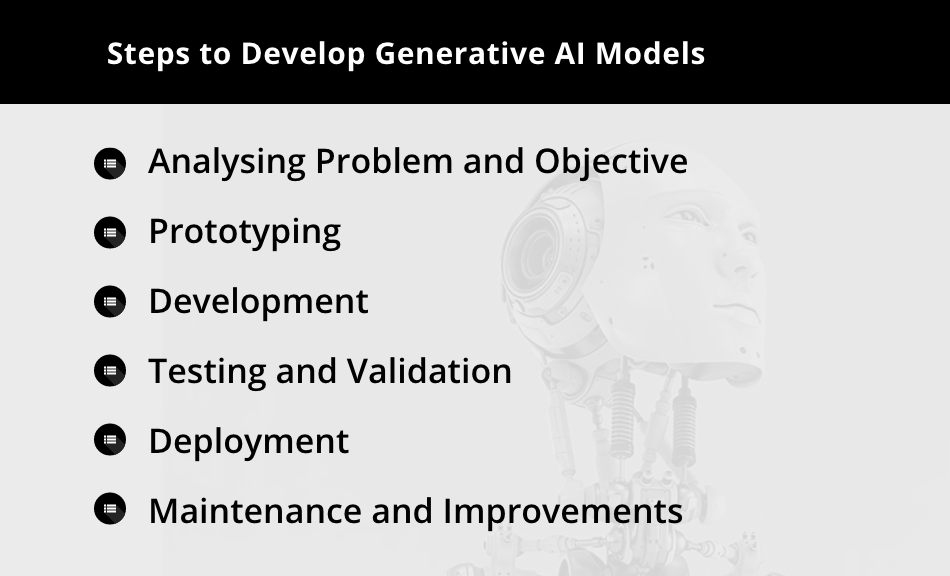
Every technology endeavor begins with an identifying challenge or need. In the context of generative AI development solutions, it is significant to comprehend the problem to be addressed and the desired output.
The process of understanding the problem and the objective comprises the issues that you want to solve by creative Generative AI like style transfer, image synthesis, realistic images, and more.
This step of the Generative AI development timeline involves building a simplified version of the AI model to test its core functionalities and assess its potential.
Prototyping also enables the stakeholders to visualize the AI system’s potential, identify potential challenges, and iterate on the design as needed. Prototyping includes the following steps:
The output accuracy and overall quality of the Gen AI solution depends on the Generative AI algorithm/model selected for it. Whether it is VAEs, GANs, or any other model, it is important to select the algorithm that best suits the task.
To ensure the effectiveness of the AI model, you should also consider the nature of your data, whether it is images, text, or other forms, and the desired output.
The collection process requires meticulous sourcing of high-quality data, ideally the representative of the problem domain, and may include text, images, or other relevant data types.
Once gathered the data undergoes a rigorous preparation process which entails cleansing, formatting, and structuring the dataset to eliminate errors, noise, and inconsistencies.
After the selection of the algorithm, it is time to train your Generative AI model by feeding it with annotated data and curated datasets. The training process involves iterations, where your model refines its capabilities, progressively improving its performance.
Start by setting up a generative AI development environment that further enables the developers to build, debug, and deploy a generative AI model.
Once you have the development environment ready, it is time to code. Let’s have a look at the ideal tech stack required for developing a generative AI solution.
| Programming Langugage | Python |
| Deep Learning Framework | TensorFlow or PyTorch |
| Data Processing | NumPy, Pandas, spaCy, NLTK |
| GPU Acceleration | NVIDIA CUDA, CUDA Deep Neural Network Library (cuDNN) |
| Cloud Services | AWS, Azure, Google Cloud, IBM Cloud |
| Model Development | TensorFlow Serving, PyTorch |
| Web Framework | Flask, FastAPI, Django |
| Database | MongoDB, PostgreSQL |
| Automated Testing | PyTest |
| Visualization | Matplotlib, Seaborn, Plotly |
| Experimental Tracking | TensorBoard, MLflow |
You can hire QA testers at this stage to execute the rigorous procedures to confirm that the generative AI development solutions are aligned with the intended objectives.
Similar to mobile app testing services, this testing includes unit, performance, user, functional, and more. Furthermore, the validation checks confirm that the solution meets predetermined accuracy and quality benchmarks.
This stage shifts the focus towards transitioning the AI model from a controlled development environment to a real-world application. Key deployment specifications of the generative AI for product development include the selection of the appropriate hardware infrastructure to support the AI model’s computational requirements and ensuring the scalability to accommodate varying workloads.
The process of deployment also involves integration with existing systems, thorough testing, and continuous monitoring for performance optimization and error detection.
Improvements are vital to enhancing the AI system’s capabilities and efficiencies over time, making investing in artificial intelligence more significant. Maintenance includes the routine checks, updates, and troubleshooting required to ensure that the AI solution operates seamlessly and also remains up to date with the latest advancements.
Before diving into the generative AI development solutions, it is important to explore the generative AI tools for software development, including components, frameworks, tech tools, and algorithms that power the Generative AI systems.
It allows developers to realize their ideas by utilizing their understanding of their customers and the domain, without needing the technical expertise required at the infrastructure level. This ecosystem of generative AI development solutions comprises four elements: data, models, evaluation platform, and deployment.
One of the prominent generative AI techniques, the application framework helps in incorporating and rationalizing the new developments. It also simplifies the process of creating and updating the applications. Various frameworks such as Fixie, LangChain, Microsoft’s Semantic Kernel, and Google Cloud’s Vertex AI platform have gained popularity over time.
Foundation models in generative AI development solutions serve as the brain of the system, capable of reasoning similar to humans. There are various FMs for developers to choose from on the basis of output quality, context window size, modalities, cost, and latency. Developers can also opt for proprietary FMs created by the vendors, such as Anthropic, Open AI, or Cohere, to host one of the many open-source FMs, or even train their own model.
It is important for the developers to have a balance between the model performance, inference cost, and latency. By iterating on prompts, fine-tuning the model, or switching between the model providers, performance can be improved across all the vectors.
Generative AI development solutions are poised to drive the next generation of apps, further transforming how we approach content development, programming, visual arts, and other creative design and engineering tasks. Some of the significant areas where generative AI finds application are:
With artificial intelligence, your photos can now look even more lifelike as the AI algorithms have the power to detect and fill in any missing, obscure, or misleading visual elements in the photos. With Generative AI, users can transform text into images, and also generate realistic images based on a setting, image, subject, style, or the location that they want to specify. By bringing AI creativity in businesses, you can also transform your low-resolution photos into high-resolution masterpieces that look highly advanced and elegant.
This AI-generated image was produced based on a description of ‘teddy bears shopping for groceries in ukiyo-e style’.

Source: OpenAI Dall-E
When it comes to making a film, every director has a unique vision for the final product, and with the power of generative AI development solutions, that vision can now be brought to life in ways that were previously impossible. Whether it is adding a dramatic flair or enhancing the natural beauty of a scene, AI can help filmmakers achieve their artistic vision like never before.
Unlock the full potential of generative AI technology and enhance programming skills. With AI, you can now generate builds of program code that address the specific application domains of interest, further making it easier to create high-quality code that meets your unique needs.
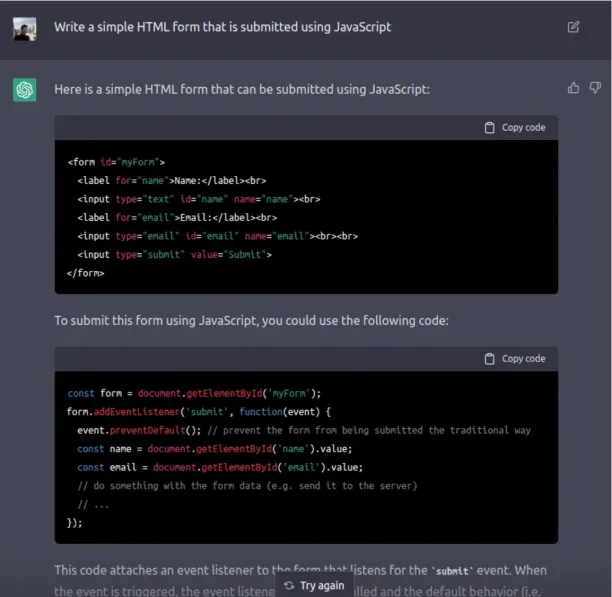
Source: OpenAI’s ChatGPT
Experience the next generation of AI-powered audio and music technology with Generative AI. This technology helps in translating text to speech with remarkable naturalness. Whether you’re creating a podcast, audiobook, or any other type of audio content, AI text-to-speech tool can bring your work to life. By using generative AI solutions, these tools help create a genuine connection with your audience.
Following the best practices while building Generative AI development solutions helps in making the process smooth as well as productive. Some of the best practices to follow are:
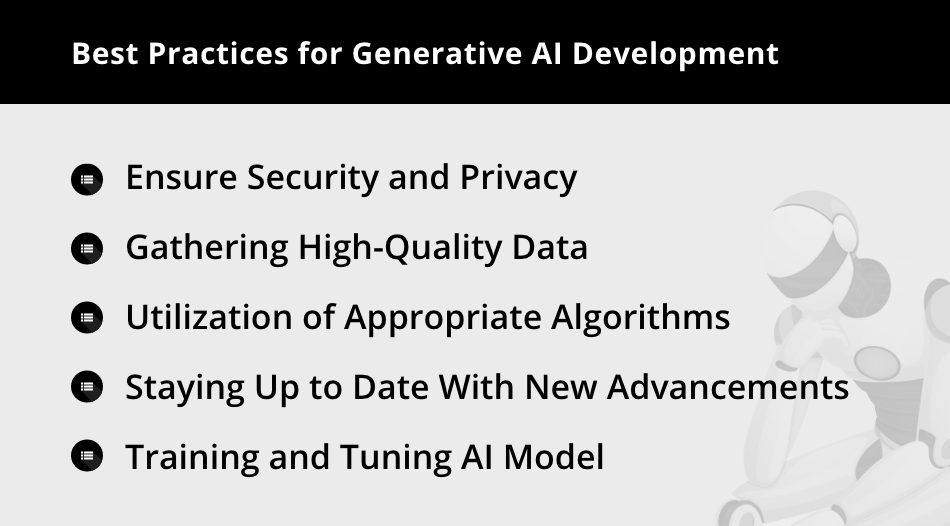
The quality of the input data directly impacts the output of the Generative AI development services.
It is essential to ensure that the data you gather is free from errors, biases, and inconsistencies, apart from being relevant and well-structured. When you feed your AI model with good data, it learns to generate more accurate and meaningful outputs, further making your solution more reliable and effective.
This practice entails taking important steps to protect sensitive information and maintain the privacy of individuals. From deploying strong encryption methods to access control mechanisms, such robust security measures protect against unauthorized access and data breaches.
One of the most crucial aspects of building a generative AI solution is the selection of the right algorithm/model. Picking the right algorithm/model ensures that the generative AI systems perform efficiently and produce high-quality outputs.
Keeping up with the latest advancements in tools, technology, algorithms, models, and more helps in enhancing the role of Artificial Intelligence in business to further ensure that their solutions are equipped with the most advanced capabilities, making them not only effective but also efficient.
To make your AI model work its best, it is important to tweak its learning rate, batch size, and epochs. These tweaks help the AI perform its tasks more accurately, and efficiently. The fine-tuning also ensures that your generative AI model is generating high-quality and accurate results for the specific task or application.
Let’s explore the top generative AI development tools that are shaping the present and future of the technology.
ChatGPT, an OpenAI creation, is a dynamic language model known for its remarkable ability to produce lifelike text. While understanding how to make an AI chatbot like ChatGPT, it is important to understand the exceptional versatility showcased by ChatGPT, which includes crafting natural conversations answering queries, and aiding creative writing.

Source: OpenAI
Bard emerged as a cutting-edge chatbot and content-generation tool developed by Google. It leverages LaMDA, a transformer-based model, and stands as Google’s response to ChatGPT. Bard works as an essential generative AI development tool by aiding in brainstorming ideas, generating code snippets, and solving programming-related queries.

Source: Blog.Google
A revolutionary coding assistant, Alpha Code leverages generative AI to empower developers. It excels in writing code, and bug resolution, and suggests the optimal programming solutions. Developers also embrace AlphaCode for hastened workflows, language acquisition and task automation.

Source: deepmind.google
GPT-4 represents a leap forward in the AI language models, further boasting enhanced text generation across various domains. It shines in the content creation, aiding writers, marketers, and educators. Its versatile use in natural language processing tasks elevates the data analysis.

Source: OpenAI
Duet AI for Google Workspace, as one of the examples of generative AI, seamlessly integrates with the Google applications. It uses a robust large language model (LLM) as its foundation. The tool leverages generative AI capabilities to facilitate text generation while also providing AI-driven code assistance for cloud users. Duet AI also seamlessly integrates with well-known Google applications such as Gmail and Meet.

Source: Medium
To grow in the changing landscape of technology, it has become important to harness the altering power of artificial intelligence for the business. Appventurez, one of the leading app development companies, excels in offering top-notch custom AI solutions that are tailored to your unique needs.
With a track record of excellence and innovation, we bring a wealth of experience to the table.
Our team of skilled AI developers specializes in crafting custom AI solutions, AI-powered wearable software, NLP solutions, and seamless AI integration.
With our expertise and commitment to excellence, we help unlock the full potential of AI technology. We also guide you on a journey into the future of AI innovation and to experience the power of intelligent solutions like never before.
Q. What is Gen AI?
Generative AI or generative artificial intelligence refers to the use of AI to create new content, like images, text, audio, music, and videos. It is powered by foundation models that can multi-task and perform out-of-the-box tasks, including summarization, classification, and more. Additionally, with minimal training required, foundation models can be adapted for targeted use cases with very little example data.
Q. How to make an AI model?
To make an AI model, you need to identify the problem you are trying to solve, collect the right data, create algorithms, train the AI model, choose the right platform, pick a programming language, and finally deploy and monitor the operation of your AI system.
Q. How to create generative AI models?
Building a generative AI model requires a deep understanding of both the technology and the specific problem that it aims to solve. It involves the designing and training of the AI models to generate novel outputs based on the input data, often optimizing a specific metric.
Q. How generative AI works?
Generative AI relies on neural network techniques such as transformers, GANs, and VAEs. Other kinds of AI, in distinction, use techniques including convolutional neural networks, recurrent neural networks, and reinforcement learning.


Elevate your journey and empower your choices with our insightful guidance.

CEO at Appventurez
Ajay Kumar has 15+ years of experience in entrepreneurship, project management, and team handling. He has technical expertise in software development and database management. He currently directs the company’s day-to-day functioning and administration.
You’re just one step away from turning your idea into a global product.
Everything begins with a simple conversation.